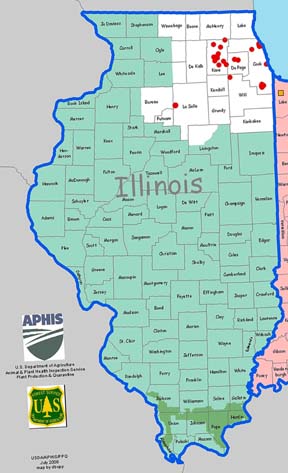Emerald Ash Borer Update | |
|---|---|
| July 10, 2008 | |
|
Emerald ash borer has been found recently in Algonquin in south-central McHenry County. This sighting is just a few miles north of previous finds in Kane County, so not unexpected. Similarly, the new location in Golf is just west of previous finds in Wilmette, Evanston, and Skokie. All of these are within the previously quarantined area of northeastern Illinois. The increase in new locations of emerald ash borer this year is probably a factor of established colonies of insects moving out to new locations. An initial infestation is likely to be just a few beetles attacking a few nearby trees. Research conducted in Michigan indicates that this small population of beetles is content to attack just these few trees for a couple or more years. The next suitable host location is likely to be on the same tree or one nearby. During this time, apparently very little spread of the population occurs. Once this localized population has built to higher numbers, the original small number of trees is now in decline and no longer providing as high of food quality. At this time, the population explodes from its original area, with beetles flying relatively long distances to find new hosts. The multiple new finds this year are probably the result of this long-distance dispersion that likely occurred about 4 years ago. Although the initial infestations of emerald ash borer were discovered only in June and July of 2006 in central Kane County and northern Cook County, these infestations were estimated to have already been present for about 6 years at that time. These estimates were based on the number of beetles present and the decline of attacked trees. By the time these infestations were discovered 2 years ago, they were already large enough to have dispersed to other areas. Some of these areas of dispersion may be some of the ones that have been found this year. Others are likely to be due to other accidental introductions, including those found in Peru, Glendale Heights, Hazel Crest, and Chicago, because they are farther away than the beetle is likely to fly and infestations have not been found between them. At this time, it appears that these were human-mediated, likely from the transport of firewood or as hitchhikers on vehicles from other infested areas in northeastern Illinois or from other infested states. Remember that trap trees were established at a fairly high density throughout northeastern Illinois through 2007. Trap trees have been shown to be more sensitive to picking up smaller infestations of emerald ash borer than the purple traps that were instituted this year. However, because an initial infestation appears to be limited to just a few trees in close proximity to each other for a few years, a trap tree would need to be one of those few trees to pick up an early infestation. A trap tree perhaps as close as a block or two away would not be likely to attract beetles to it until the core trees went into decline. These same trap trees, as well as arborists, other professional horticulturists, and the public, would be likely to find at least large infestations between these sites. Even so, we are likely to find additional infestation sites during the next few months. These finds are likely to continue the build over the coming few years until at least northeastern Illinois becomes generally infested. The good news is that there is no evidence of far-flung infestations except for the Peru infestation found last year. There have been no additional finds along Interstate 80 in Illinois, and no other downstate infestations have been found. This serves as a reminder that preventive systemic insecticide treatment of ash trees is not recommended more than 15 miles from a known infestation. This 15-mile radius encompassed essentially all of the Chicago metropolitan area but not other areas the state except for the area around Peru. With an eradication cut having been completed at the Peru location, we are hopeful that no more infestations will be found over the next few years in that area. Remember that research indicates a high percentage of at least short-term recovery of attacked trees exhibiting up to 40% dieback when treated with systemic insecticides. Research has not been conducted for enough years to determine long-term survival of treated trees, but it is expected. This makes preventive treatment of trees that have not been attacked by emerald ash borer even less necessary. | |
| Author: | Phil Nixon |

